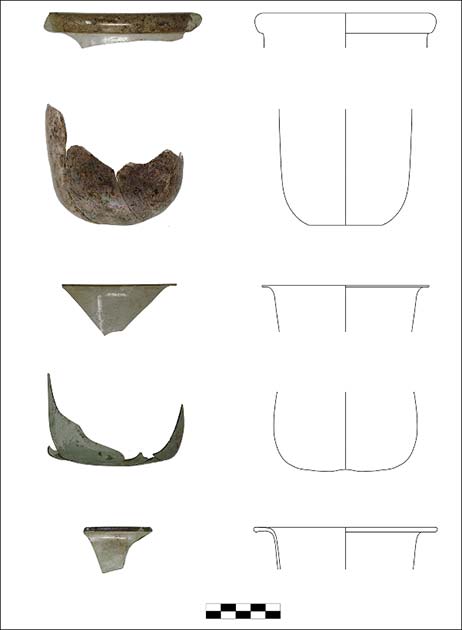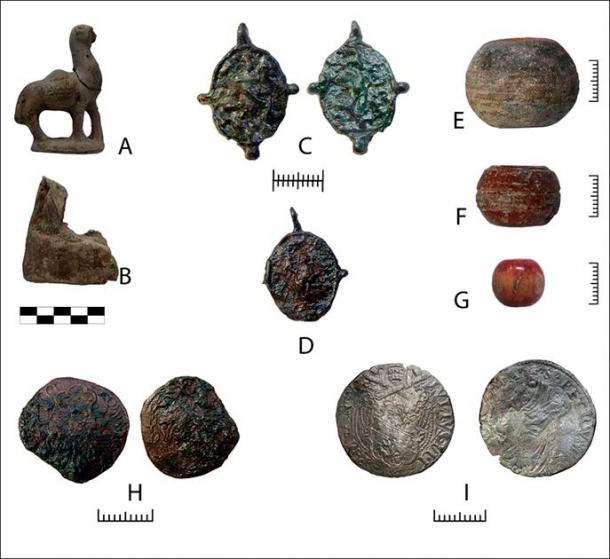
Renaissance Era Medical Dump Includes Urine Flasks For Tasting Pee!
A team of researchers from Denmark and Italy have stumbled upon a treasure trove of artifacts at an ancient Roman hospital site in Rome brimming with medical supplies. This Renaissance-era trash dump inside the Forum of Caesar include 500-year-old medicine bottles and urine flasks, used to collect patient’s pee for medical analysis. Urine flasks ( matula in Medieval Latin) are often confused with oil lamps, for they carry the same shape, but are rarely ever found in any other context than a former hospital site.
"The patient's urine would be poured into a flask to allow a doctor to observe its color, sedimentation, smell, and sometimes even taste," project directors Rubina Raja, Jan Kindberg Jacobsen, Claudio Parisi Presicce and other colleagues write in the study published in the journal Antiquity’s April edition.

Glass urine flasks excavated from the cistern. (Sovrintendenza Capitolina – The Caesar's Forum Project/Antiquity Publications Ltd)
Ospedale dei Fornari and The Urine Flasks
The dump was initially found in 2021, discovered in an area completed in 46 BC, and dedicated to Julius Caesar. However, a millennium and a half later, a guild of bakers built the Ospedale dei Fornari (Baker’s Hospital) in the same space.
The dump was then created by the workers, giving a glimpse into the practices of waste disposal that have existed for centuries. The fact that these artifacts would have been “potentially infected” with pathogens helps to “[shed] light on urban waste-management practices” of Roman society, researchers noted.

The brick-built cistern (context 1154) during excavation in 2021. (Caesar’s Forum Project/Cambridge Antiquity)
Archaeologists found a Renaissance-era cistern filled with ceramic vessels, rosary beads, broken glass jars, and personal items like coins and a ceramic camel figurine. Many of the objects were related to routine patient care at the hospital, with each person admitted given a welcome basket as a hygienic measure. This was part of a larger ‘patient toolkit’ suggest the researchers.
The team of researchers from Denmark and Italy discovered a sealed cistern while excavating Caesar’s Forum, a 2,000-year-old public space in central Rome, as part of the Caesar’s Forum Project. The cistern, which was 9 feet (2.75 meters) deep and dated back to the second half of the 16th century, was filled with trash and sealed with clay, left untouched for centuries until it was uncovered by the team.
- Poisonings Went Hand in Hand with the Drinking Water in Ancient Pompeii
- Rats, Exploding Toilet Seats and Demons of the Deep: The Hazards of Roman Sewers
During the Renaissance, doctors recognized that diseases could spread through human contact or contaminated objects, leading hospitals to develop protocols for the proper disposal of infected objects, especially during plague outbreaks. Excavations of the dump uncovered a range of artifacts, including small, intact medicine containers, glass medical vessels, and urine flasks.
Urine flasks were used to collect a patient’s urine, which doctors would then analyze for its color, sedimentation, smell, and taste – a uroscopy, a diagnostic technique dating back to the days of Hippocrates. By examining the characteristics of the urine, doctors could diagnose certain conditions such as diabetes, which would cause the urine to have a sweet smell and taste due to excess glucose, reports Live Science.
Other Items in the Dump and a Not So Efficacious Waste Disposal
Other items found in the dump include cooking vessels and other items used for serving food. Sixteenth-century Roman hospitals issued single-serving plates, bowls, and jugs to patients when they were admitted, with the use of these kitchen items restricted to each individual patient.
The dump also contained personal belongings of patients, such as ceramic figures, two bronze medals, several coins, and a rosary bead, providing insight into the lives of those who were treated at the hospital.

Minor personal objects from the 2021 dump, comprising terracotta figurines, devotional medals, rosary bead and spindle whorls. Coin: Leo X, minted between AD 1513 and 1521 (bronze); Julius III, minted between AD 1550 and 1555 (silver). Scales in cm. (Caesar’s Forum Project/Antiquity Publications Ltd)
Archaeologists working on the site noted overriding similarities between the items found at Caesar’s Forum and another nearby rubbish site outside the Ospedele dei Fornari, which was excavated in 2009. Almost all the vessels found at the 2021 dump have direct parallels to artifacts from the 2009 dump, leading researchers to suggest that all the material originated from the same hospital complex. The hospital likely filled the closer, larger dump site and then diverted waste to a more distant location at Caesar’s Forum.
- Hippocrates Did WHAT to Treat Hemorrhoids?
- Medieval Medical Books Could Hold the Recipe for New Antibiotics
Despite being prohibited, the deposition of waste in cellars and cisterns was common practice, perhaps even the go-to disposal method for infectious waste, the study explains. What is particularly significant is that the dating of these finds coincides with a boom in urbanization in European cities across the continent, which led to a plethora of diseases and repeat epidemics due to poor sanitation and hygiene practices.
Top image: Selection of urine flasks and bottles found at the disposal site at the Ospedale dei Fornari. Source: Caesar’s Forum Project/Antiquity Publications Ltd
By Sahir Pandey
References
Boscetti, C., et al. 2023. Disease control and the disposal of infectious materials in Renaissance Rome: excavations in the area of Caesar's Forum. Available at: https://doi:10.15184/aqy.2023.34.
Cost, B. 2023. ‘Urine flasks’ for drinking, diagnosing discovered at ancient hospital site. Available at: https://nypost.com/2023/05/01/archaeologists-unearth-medical-flasks-for-swilling-urine/.
Killgrove, K. 2023. Ancient 'urine flasks' for smelling (and tasting) pee uncovered in trash dump at Caesar's forum in Rome. Available at: https://www.livescience.com/archaeology/romans/ancient-urine-flasks-for-smelling-and-tasting-pee-uncovered-in-trash-dump-at-caesars-forum-in-rome.
Pflughoeft, A. 2023. Urine flasks — for smelling and tasting pee — found in 400-year-old dump in Italy. Available at: https://www.miamiherald.com/news/nation-world/world/article274916226.html.















